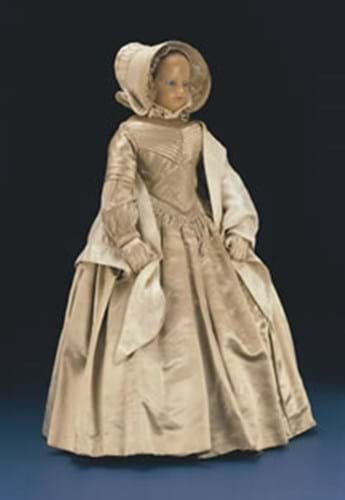
And there is a time-honoured way of circumventing the plain dress requirements of Quaker society: choose a plain fabric of the most sumptuous kind and swathe it generously around you to reveal its glory, and make sure every tuck and flap points to your own sense of style.
Better still, after the wedding, have one of the best doll makers of the day make a model dressed in replica bridal regalia. Who could deny you this in an age before photography became common, especially if your own daughter was then able to keep the doll for her own lifetime and for posterity.
This is the story of the Quaker bride, the doll pictured here, that sold at Christie's South Kensington's specialist auction on May 26 for a substantial £4800. £900 m ore than ot fetched when it last went under the hammer at Bonhams in 1994.
It may not have been the most expensive doll of the day, but it is probably the most interesting. It came with a note stating that it was dressed in clothes replicating those worn by the Quaker Suzanna Maria Birchall on the day in June 1841 that she married William Willcocks Fennell, aged 20.
The 221/2in (57cm) high doll, with blue glass eyes, closed mouth, stuffed body and poured wax head and arms, came in its original wooden box with packing, the body signed Montanari Counter 130 Soho Bazaar. She was dressed in an 1840s-style cream duchesse silk satin wedding gown, with net cap, cream ribbed silk bonnet and shawl with kid gloves.
Grantham-born Mme Montanari was doll maker to Queen Victoria's children and was known for the exquisiteness of her dolls' clothes as well as for her attention to the detail and trimmings of dress. She went on to have a large display at the 1851 Great Exhibition and one of her dolls from the exhibition now resides in the Grantham Museum.
It seems that Suzanna may have bought a poured wax doll made by Madame Montanari and that her younger sister, Anna, made its underclothes, consisting of stays, silk stockings and black satin slippers with silk ribbons. Some time between then and 1845 Madame Montanari made the replica bridal clothes for the doll, which then made its way to her stand at the Covent Garden Bazaar in May 1845. The Bazaar was an event organised by the powerful Anti-Corn Law League (formed 1839) to raise funds for protest against the protectionist policies of the Corn Laws, which kept the price of bread artificially high and disadvantaged the growing urban population in favour of agricultural land owners. The Quakers' belief in social reform guaranteed their support for the Anti-Corn Law League and hence they were involved with many of its fund-raising activities, including the 1845 Bazaar. The doll was bought back by the Birchall/Willcocks family at the Bazaar for Suzanna and William's eldest daughter.
Vivienne Lawes




